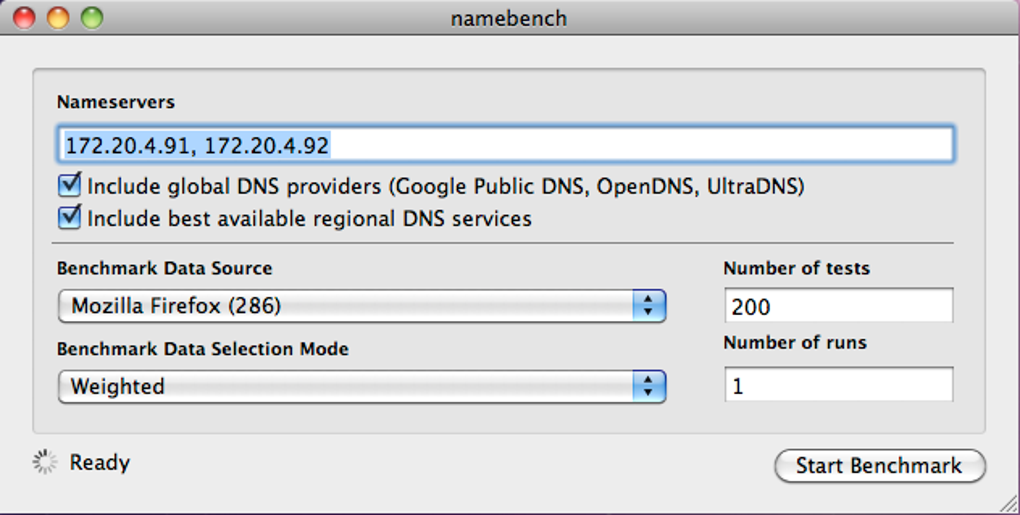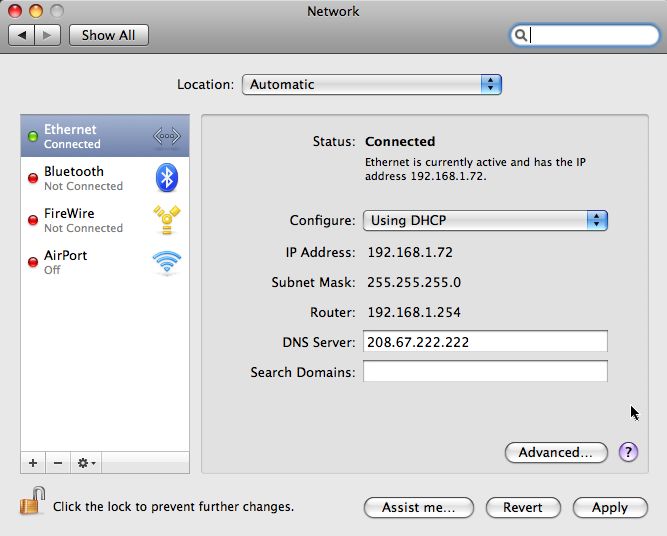On your Mac, choose Apple menu System Preferences, then click Network. Open Network preferences for me. In the list at the left, select the network connection service you want to use (such as Wi-Fi or Ethernet), then click Advanced. Click DNS, then click the Add button at the bottom of the DNS Servers list. Enter the IPv4 or IPv6 address for. In such cases, flushing your Mac OS DNS cache may be necessary to pick-up the updated entries without waiting for the TTL to expire. Unfortunately, there is not one consistent way to do it as it will depend on which Mac OS version you are running.
There have been two major changes in DNS resolution in Mac OS X Snow Leopard as compared to Mac OS X Leopard and previous releases, and this tip is intended to explain them.1) User-specified DNS servers, if any, are now used to the exclusion of all others
DNS server addresses may be manually-specified by users via the Networking preference pane by selecting the active interface ( e.g. AirPort, Ethernet, etc.), the clicking the 'Advanced…' button in the lower right hand corner of the window, and selecting the 'DNS' tab.
DNS server addresses may also be provided by a DHCP server.
In Mac OS X Snow Leopard, if any DNS servers are manually specified, they will be the only DNS servers consulted; any DNS servers specified via DHCP will be ignored
This differs from Mac OS X Leopard and previous releases of Mac OS X, as in those releases, if DNS servers were specified manually as well as provided via DHCP, the manually-specified server(s) would be queried first, and if those requests failed, requests would then be sent to any DNS server(s) specified via DHCP.
This means that in Mac OS X Snow Leopard, if queries to manually-specified DNS servers fail, the request will be considered to have failed and no DHCP-specified DNS server will ever be queried.
Users may encounter this because at some point a DNS server (which is no longer functioning or reachable) was manually set in a work or other environment and they had forgotten about it since the previous behavior was for failed requests to 'fall through' to DHCP-specified servers.
Because of the change in behavior, those same systems will fail to resolve any DNS requests in Mac OS X Snow Leopard.
2) mDNSResponder does not honor DNS server ordering
While not explicitly documented, in Mac OS X versions earlier than Snow Leopard, DNS servers, whether specified manually or via DHCP, were queried in the order they were provided. For manual specification, this means in the order shown in the appropriate Network preferences pane tab, and for DHCP users in the order specified by the DHCP server.
This is no longer true in Mac OS X Snow Leopard; instead mDNSResponder now seems to occasionally change the order in which it queries DNS servers from that in which they were specified.

Dns Server For Mac Os X
This has caused some users issues when DNS servers are specified in a specific sequence.For example, say your network has two DNS servers, a main server at address 192.168.100.1, and a secondary server at 192.168.100.2, which is normally only to be used if the primary DNS server fails as it is slower and/or has a slower link to the Internet.
If they were specified in that order, past versions of Mac OS X would query them in that order, and unless a failure occurred contacting the primary server, the second server specified would never be contacted.
In Mac OS X Snow Leopard, under various conditions mDNSResponder will instead decide to route all DNS queries to the second DNS server specified, perhaps as a method of routing DNS queries in a round-robin fashion.
Nevertheless, this behavior is unexpected to most users, and may cause issues if the previous behavior was expected.
The only workaround is to realize that Mac OS X Snow Leopard treats all specified DNS servers as being equally capable and to specify DNS servers, either manually or via DHCP, accordingly.
This is the 1st version of this tip. It was submitted on November 15, 2009 by William Kucharski.
Quad 2.5 GHz G5, 5 GB | 15' 2.6 GHz MBP Penryn, 4 GB | 1 TB Dual-Band TC, Mac OS X (10.6.1)
Posted on

I love playing with various OS’s and in OSX is on top of my list. During the day I am managing IT from my old trusted Lenovo ThinkPad with Windows. At night I am using my MacBook PRO. And I love it. The more and more I use it for various tasks the more I am looking for alternatives to Windows commands.
Why would you flush DNS cache in the first place?
Whenever there is a change in DNS, for example you change IP ADDRESS of a website, DNS is still caching old entry. But when you flush it, all the records are gone, then DNS will have to query DNS again to obtain the latest address.
I was asked by my friend how to flush DNS in Mac OS X… I didn’t know, I admit. In the end it’s fairly easy.
Flush DNS in Mac OS X Snow Leopard 10.6
Open terminal and type:dscacheutil -flushcache
this is quite similar to windows, instead of ipconfig /flushdns you type dscacheutil -flushdns
Flush DNS in OS X Lion (10.7) and OS X Mountain Lion (10.8)

With Lion, there is a bit more typing to do. Luckily same applies to Mountaion Lion as well.
sudo killall -HUP mDNSResponder
dscacheutil still works in 10.8 and 10.7 but official method is to kill mDNSResponder. As alternative you can kill process in Activity monitor.
Mac Os X 10.11 Download
Flush DNS in OS X 10.9 Mavericks
If you are running 10.9 version of OS X, you will have to type even more, by executing command below you will do two things: 1. You will flush cache 2. then you will reload DNS for changes to come in effect.
Dns Cache Mac Os X
dscacheutil -flushcache;sudo killall -HUP mDNSResponder
How to clear DNS cache in OS X 10.10 Yosemite

To completely clear DNS cache in OS X 10.10, you will have to target MDNS – Multicast DNS and UDNS -Unicast DNS with two different commands but they can be merged in to one. Open terminal and type:
sudo discoveryutil mdnsflushcache;sudo discoveryutil udnsflushcaches;say flushed
You can also type each command separately.
In order to clear MDNS cache type in the following command:
sudo discoveryutil mdnsflushcache
In order to clear UDNS cache type in the terminal the following command:
sudo discoveryutil udnsflushcaches
Yes, it’s not a mistake, you have to use plural
How to clear IOS DNS cache
IOS does not have a terminal which you can use to type in commands like in OS X. One solution which will work on IOS is to restart the device. But in this case, it will take a lot of time.
What you can do is to enable and disable flight mode. Go to Settings, Airplane mode and turn it ON. Wait for several seconds and turn Flight mode OFF. This will clear DNS cache. In IOS version 7 and above, you can pull up new menu at the bottom (quick access) and press first icon on the left – flight mode. Wait for several seconds, and press it again to turn flight mode off. You can use this method to clear DNS cache on iPhone and iPad.
Related

